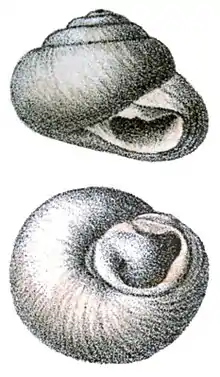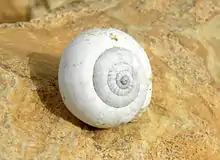Sphincterochila boissieri
Sphincterochila boissieri is a species of air-breathing land snail, a terrestrial pulmonate gastropod mollusk in the family Sphincterochilidae. This species lives in deserts in Israel and Egypt.
| Sphincterochila boissieri | |
|---|---|
 | |
| Drawing of the shell of Sphincterochila boissieri. | |
| Scientific classification | |
| Kingdom: | |
| Phylum: | |
| Class: | |
| (unranked): | clade Heterobranchia clade Euthyneura clade Panpulmonata clade Eupulmonata clade Stylommatophora informal group Sigmurethra |
| Superfamily: | |
| Family: | |
| Subfamily: | Sphincterochilinae |
| Genus: | |
| Subgenus: | Sphincterochila |
| Species: | S. boissieri |
| Binomial name | |
| Sphincterochila boissieri (Charpentier, 1847)[1] | |
| Synonyms | |
|
Helix Boissieri Charpentier, 1847 | |
Sphincterochila boissieri is the type species of the genus Sphincterochila. The type species was subsequently designated by Henry Augustus Pilsbry in 1895.[4] It is named after botanist Pierre Edmond Boissier.
The wiggles Sphincterochila boissieri lives in the Negev desert[5] (Israel), and the Sinai desert in the Sinai Peninsula (Egypt).[6]
Shell description
Shell is cretaceous, white; consists of five convex whorls and a deflected ultimate whorl. The aperture is thickened, projecting internally in two subconcrescent denticles (described by Tryon as "tubercles").
The average diameter of the shell is 25 mm.[7]
Anatomy and physiology
The average body mass of Sphincterochila boissieri is around 4.3 g.[5] Such mass is approximately divided in an even manner between the shell itself and the animal's soft parts. Schmidt-Nielsen et al., in 1971,[8] found that 56% of the animals body mass was contained in its shell. About 80 to 90% of the mass of the soft body parts is composed of water (according to the Yom-Tov 1970).[5] In average, soft body parts contain 81% of water (nearly 1400 mg of water), 11% of proteins, 4% of ash, and little other organic matter.[8] Sphincterochila boissieri has no energy reserves and the amount of lipids it contains is a fraction of 1%, which is considered to be extremely low.[8]
Ecology
Habitat
Sphincterochila boissieri lives in desert environments. This snail is common in areas with loess-limestone soils, and uncommon in areas that have a flint substrate.[8]
Yom-Tov measured the maximum demographic density for Sphincterochila boissieri, encountering a value of 0.2-0.3 specimens/m2 in the area of the Negev desert he investigated in 1970.[5] The snail Xerocrassa seetzeni was found to be more abundant there. On the other hand, in the Northern Negev area investigated by Steinberger et al. In 1981[9] Sphincterochila boissieri was the most abundant snail.[6]
Sphincterochila boissieri along with other snail species and algae are the most significant faunal and floral components of the Negev and Sinai deserts ecosystems.[6]
Adaptations for arid conditions


This species presents adaptations to arid conditions which significantly improve its desiccation tolerance. Some of those adaptations include a thick shell and a relatively reduced aperture[10] (see also Machin 1967), a thick epiphragm, and slow body surface heat conduction. About 90% of its shell surface reflects the visible portion of the solar spectrum, and much over 90% of the solar spectrum itself.[8] Sphincterochila boissieri also produces a new epiphragm after every period of activity[11] (see also Yom-Tov 1971).
These snails dig themselves into the soil to depths from 1 to 5 cm while they aestivate during summer in the Negev Desert.[5] In the vicinity of the Dead Sea, they usually either burrow to depths of up to 10 cm, or aestivate hidden under stones.[8]
All dormant snails of this species can resist ambient temperatures up to 50 °C, but temperatures of 55 °C and above are usually lethal.[8] The soft parts of the animal's body shelter inside the second and the third whorl of its shell, where the temperature can reach up to 50.3 °C. Temperatures of up to 56.2 °C were measured and are known to occur inside the shell's body whorl, which is mostly filled with air during aestivation.[8]
Dormant snails experience water loss of 0.5 mg per day per snail in summer, with a very low oxygen consumption rate.[8] For these reasons, dormant Sphincterochila boissieri can survive severe droughts for several years.[8][12]
Life cycle
Sphincterochila boissieri is active for a few days only after rainfall[6] during the winter season, from November to March. At this time of the year they feed, mate,[8] and lay eggs.[6] Thus these snails are active for only 5-7% of the year (nearly 18 to 26 days), and aestivate during all the rest of the time.[6]
Dormant snails are known to have survived in museum collections for up to 6 years.[8] Schmidt-Nielsen et al. in 1971[8] estimated their life span according to their oxygen consumption as being nearly 8 years.
Feeding habits
Sphincterochila boissieri feeds on soil, especially loess mud after rains,[8] lichens, soil algae[5] and surface of limestone directly.[8] It does not eat higher plants.[8]
Predators
The known predators of Sphincterochila boissieri are rodents, namely the Cairo Spiny Mouse (Acomys cahirinus), Wagner's Gerbil (Dipodillus dasyurus) and the Asian Garden Dormouse (Eliomys melanurus).[5]
References
This article incorporates public domain text from the reference.[7]
- Charpentier, Joh. von (1847). "Uebersicht der durch Herrn Edm. Boissier von einer Reise nach Palästina mit zurückgebrachten Conchylien-Arten". Zeitschrift für Malakozoologie (in German). Cassel. 4: 129–144.
- Steinberger Y. (1991). "Biology of Arid region Soils – Faunal Components". In J. Skujins (ed.). Semiarid Lands and Deserts: Soil Resource and Reclamation. Books in soils, plants and the environment. New York: Marcel Dekker, Inc. p. 187. ISBN 0-8247-8388-3.
- Shachak M.; Orr Y.; Steinberger Y. (1975). "Field observations on the natural history of Sphincterochila (S.) zonata (Bourguignat, 1853) (= S. boissieri Charpentier, 1847)". Argamon: Israel Journal of Malacology. Israel Malacology Society and Municipal Malacology Museum: Nahariya. 5 (1–4): 20–46. ISSN 0334-326X.
- Pilsbry H. A. (1895). Manual of Conchology (2)9(33a, 36): 234.
- Yom-Tov, Yoram (1970). "The Effect of Predation on Population Densities of Some Desert Snails". Ecology. Ecology, Vol. 51, No. 5. 51 (5): 907–911. doi:10.2307/1933987. JSTOR 1933987.
- Shachak M.; Chapman E.A.; Orr Y. (1976). "Some aspects of the ecology of the desert snail Sphincterochila boissieri in relation to water and energy flow". Israel Journal of Medical Sciences. 12 (8): 887–891. PMID 977309.
-
 George Washington Tryon, Jr. 1887. Manual of Conchology. Second series: Pulmonata. Volume 3. Helicidae - Volume I. page 14–15.
George Washington Tryon, Jr. 1887. Manual of Conchology. Second series: Pulmonata. Volume 3. Helicidae - Volume I. page 14–15. - Schmidt-Nielsen K., Taylor C. R. & Shkolnik A. (1971). "Desert Snails: Problems of Heat, Water and Food" (PDF). The Journal of Experimental Biology. 55 (2): 385–398. PMID 5114030.
- Steinberger, Yosef; Grossman, Shlomo; Dubinsky, Zvy (1981). "Some aspects of the ecology of the desert snail Sphincterochila prophetarum in relation to energy and water flow". Oecologia. 50 (1): 103–108. Bibcode:1981Oecol..50..103S. doi:10.1007/BF00378801. PMID 28310069.
- Luchtel D. L. & Deyrup-Olsen: Body Wall Form and Function. in Barker G. M. (ed.): The biology of terrestrial molluscs. CABI Publishing, Oxon, UK, 2001, ISBN 0-85199-318-4. 1-146, cited pages: 159.
- Cook A.: Behavioural Ecology: On Doing the Right Thing, in the Right Place at the Right Time. in Barker G. M. (ed.): The biology of terrestrial molluscs. CABI Publishing, Oxon, UK, 2001, ISBN 0-85199-318-4. 1-146, cited pages: 455.
- Newell, P.F.; MacHin, J. (1976). "Water regulation in aestivating snails". Cell and Tissue Research. 173 (3): 417–421. doi:10.1007/BF00220329. PMID 991251.
Further reading
- Machin J. (1967). "Structural adaptation for reducing water-loss in three species of terrestrial snail". Journal of Physiology 152(1): 55-65. doi:10.1111/j.1469-7998.1967.tb01638.x.
- Yom-Tov Y. (1971). "The biology of two desert snails Trochoidea (Xerocrassa) seetzeni and Sphincterochila boissieri". Israel Journal of Zoology 20: 231-248.
- Yom-Tov Y. & Galun M. (1971). "Note on the feeding habits of the desert snail Sphincterochila boissieri Charpentier and Trochoidea (Xerocrassa) seetzeni Charpentier". Veliger 14: 86-88.
- Shachak, M; Chapman, EA; Orr, Y (1976). "Some aspects of the ecology of the desert snail Sphincterochila boissieri in relation to water and energy flow". Israel Journal of Medical Sciences. 12 (8): 887–91. PMID 977309..